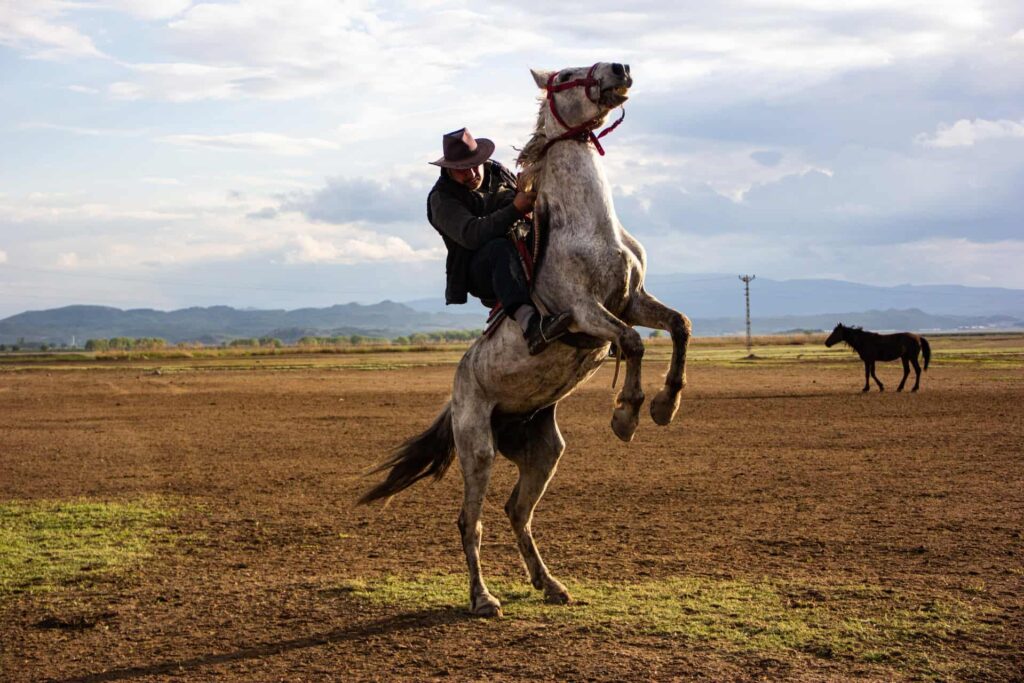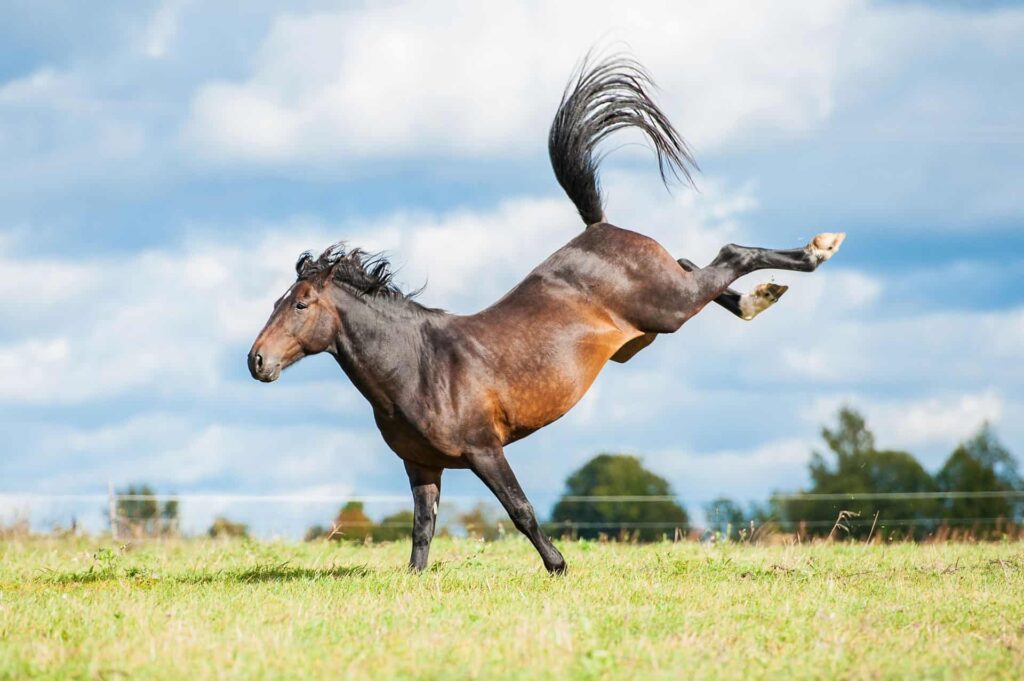Horse rearing is a complex behavior that often causes concern among horse owners and trainers. When a horse rears, it stands on its hind legs, which can pose a serious safety risk to both the animal and the handler. Understanding the reasons behind rearing is crucial for addressing the issue effectively. The behavior may stem from a variety of factors, ranging from bad habits or misunderstandings in communication to pain or discomfort in the horse.
Managing and preventing rearing begins with recognizing the individual horse’s needs and behaviors. Effective training techniques that encourage trust and respect between the horse and handler are central to mitigating the risk of rearing. Additionally, responding promptly and appropriately to rearing, should it occur, is necessary for the safety and well-being of all involved. With proper management and informed training strategies, the incidence of rearing can be significantly reduced, if not eliminated.
Key Takeaways
- Understanding why a horse rears is key to addressing and preventing the behavior.
- Building a trusting relationship through effective training can reduce instances of rearing.
- Safety of both the horse and handler is paramount when managing and responding to rearing behavior.
Understanding Horse Behavior
Horse behavior is complex and can be influenced by a variety of factors ranging from instincts to the relationship with their riders. Rearing, a specific behavior where a horse stands up on its hind legs, can be particularly dangerous. Understanding the causes, signs, and preventative measures is essential for safe and effective horse management.
Natural Instincts and Rearing
Horses are prey animals by nature, which means their instincts play a significant role in their behavior. Rearing can be a horse’s instinctive reaction to fear, nervousness, or excitement. It’s often a response to a perceived threat, such as a sudden movement that triggers their flight response.
Common Causes of Rearing
Rearing can stem from a variety of causes including fear, pain, or discomfort. Common triggers might include improper saddle fit, a painful physical ailment, or an ill-fitting halter. Each of these can cause pain or discomfort that a horse may try to escape by rearing.
Signs of Anxiety and Fear
A horse may exhibit signs of anxiety or appear fearful when faced with stress. This can include pacing, nervous behavior, or an increased heart rate. These indicators can precede rearing and should act as a warning to handlers.
Signs of Aggression or Dominance
Displaying aggression or dominance may be a horse’s means of attempting to exert control. A horse that shows its teeth, pins its ears back, or snaps, might be displaying dominance which can escalate to rearing.
Learned Behavioral Issues
Some horses may develop learned behavioral issues such as rearing in response to certain cues or situations. If rearing has been inadvertently rewarded in the past, it might become a behavioral problem.
Assessing the Environment and Stimuli
Environmental factors and stimuli like excitement or boredom can provoke certain behaviors. A thorough assessment of the horse’s surroundings can identify potential triggers.
Health and Physical Issues
Regular check-ups with the vet can prevent rearing caused by physical problems. Maintaining a record of health checks can be beneficial for identifying patterns leading to behavioral issues.
Assessing Tack and Equipment
A proper equipment check is essential. Consultation with a professional saddle fitter can ensure that pain from ill-fitting tack is not the cause of rearing.
The Rider’s Influence
The rider has a substantial impact on horse behavior. Incorrect balance, inconsistent cues, or heavy-handed use of the reins can all contribute to a horse feeling the need to rear.
Rearing as a Communication Tool
Rearing is an animal’s form of communication, often indicating confusion, fear, or the need for clearer direction. Understanding the root cause of the communication can help address the behavior.
Importance of Early Socialization
Effective schooling and the establishment of a solid foundation can reduce the likelihood of behavioral issues. Early socialization can play a crucial role in minimizing the development of rearing in horses.

Prevention and Management
Effective prevention and management in horse rearing are pivotal for both safety and behavioral excellence. They ensure the foundation for a horse’s well-being and a rider’s success.
Creating a Safe Environment
To maintain safety, it is essential to establish a secure area free from hazards that could harm the horse. For instance, sturdy fencing and the removal of sharp objects are crucial steps. A safe environment also means using equipment such as a helmet for the rider.
Proper Training and Groundwork
Groundwork lays the solid foundation necessary for any horse’s training regimen. This involves consistent work on fundamentals, such as leading and lunging before moving forward to more complex tasks.
Building Trust and Respect
The horse and handler must cultivate a relationship based on trust and respect. This dynamic is developed through consistent, fair training practices and clear communication.
Developing Rider Skills
A rider’s balance and control are paramount. They need to build their own skill set to work in harmony with their horse, ensuring clear directives and responses.
Evaluating and Adjusting Training Approaches
One should avoid looking for a quick fix in training. Instead, consistent evaluation and adjusting of training methods is necessary to align with the horse’s learning curve and behavioral responses.
Routine Health Checks
Regular consultations with a vet can preempt issues by addressing any sign of physical ailment, discomfort, or pain. This proactive management protects the horse’s health and ensures optimal performance.
Responding to Rearing
When a horse rears, it presents a dangerous situation for both the animal and the rider. Immediate and appropriate response is crucial in minimizing risk and regaining control.
Emergency Dismount
In instances where safety is compromised and balance cannot be maintained, an emergency dismount may be necessary. The rider should lean forward, remove their feet from the stirrups, and push away from the horse to avoid falling underneath the animal.
Regaining Control and Calm
Quickly regaining control is essential. The rider should remain calm, firmly hold the reins without pulling too hard, and speak to the horse in a soothing tone to reduce excitement and assert control.
De-Escalating the Situation
To de-escalate, one must identify and remove the cause of the rearing, if possible. A gentle but firm touch and reassurance can help the horse feel safer and more at ease, thereby stopping the behavior.
Reframing the Rider’s Response
The rider’s response can influence the horse’s behavior. They should stay centered in the saddle, avoid panic, and maintain a focused demeanor to help the horse transition back to a tranquil state.
Post-Rearing Actions and Assessment
After a rearing episode, thorough equipment checks should be taken to ensure the proper fit of the saddle and to rule out pain as a cause. Monitoring the horse for any signs of injury is critical.
When to Seek Professional Help
If the rearing issue persists, it might be time to seek professional help from a vet or trainer. This can prevent potential injuries and help address underlying behavioral issues.
Understanding and Mitigating Risks
Riders should educate themselves on the risks of rearing and take precautions such as wearing a helmet and ensuring a safe riding environment to prevent incidents.
Safe Restraint of a Rearing Horse
Using a halter and lead rope provides an additional means of control, allowing the rider or handler to exert influence over the horse from the ground if necessary for safety.
Dealing with Frustration or Excitement
Reducing triggers like frustration or excitement can prevent rearing. This involves consistent training, regular exercise, and understanding the horse’s behavioral cues.
Handling Fear-based Rearing
Rearing that stems from fear requires a patient and reassuring approach from the rider. They should identify stressors and introduce them gradually, building the horse’s confidence and reducing the fear response.

Training Techniques and Exercises
Training a horse effectively involves a structured approach with clear, consistent techniques and exercises. A horse and rider must establish a solid foundation built on mutual respect, and adjust training to the horse’s learning pace. It’s essential to reward positive behavior to promote a willingness to learn and to maintain the horse’s balance and coordination, which is critical for both safety and performance.
Establishing a Solid Foundation
The first step in effective horse training is to establish a solid foundation of respect and dominance without aggression. Training should start with basic ground manners where the horse learns to trust and follow the rider’s cues. These cues indicate when to move forward, turn, or stop, and become the building blocks for all future exercises.
Specific Exercises to Discourage Rearing
To specifically address and discourage rearing, one can introduce exercises that redirect the horse’s excitement or hot temperament. Utilizing techniques to keep the horse’s feet moving, like turns-on-the-forehand or serpentines, refocuses its energy and reduces the likelihood of rearing up.
Reinforcement of Positive Behavior
Reinforcing positive behavior is crucial; reward the horse with praise or a treat for compliance to create learned behavior. This not only builds willingness but also establishes a system where good behavior is associated with positive outcomes, further strengthening the horse and rider bond.
Adjusting to the Horse’s Learning Pace
Training must be adapted to the horse’s learning pace. Rushing can lead to confusion and more excitement, whereas recognizing when the horse grasps an exercise and allowing time for practice reinforces the training without overwhelming the animal.
Balance and Coordination Training
Balance and coordination are fundamental for a horse’s development. Exercises that promote these, such as working on different terrains and incorporating poles or cavaletti into the routine, help the horse become more agile and responsive to the rider’s direction, ultimately enabling smoother and safer movements.
Frequently Asked Questions
Let’s address common inquiries regarding the management, triggers, and prevention of rearing in horses, along with training strategies and associated risks.
How can rearing in horses be treated or managed?
Treatment and management of rearing in horses require understanding the individual horse’s behavior and may involve consistent groundwork, positive reinforcement, and sometimes professional help. In some cases, examining the horse’s environment and daily routine can provide insights into changes that may reduce the behavior.
What might provoke a horse to suddenly begin rearing?
A horse may suddenly begin rearing due to discomfort, fear, confusion, or defiance. Pain-related issues such as back pain or dental problems should be evaluated, and tack fit should be reassessed. Environmental stressors and changes in training routines can also be triggers.
What are effective techniques to prevent a horse from rearing while in hand?
To prevent a horse from rearing while in hand, one can employ groundwork techniques to establish respect and control. Teaching the horse to yield to pressure and using body language to communicate effectively can prevent rearing. Consistency and calm, assertive energy are key.
Why would a horse rear up when requested to back up and how can this be corrected?
A horse might rear up when asked to back up if it’s resisting the handler’s request, feeling discomfort, or if it’s confused about the command. This behavior can be corrected by building trust, ensuring clear communication, and gradually teaching the horse the desired response with patience and consistency.
What training methods are recommended for young horses that exhibit rearing behavior?
For young horses that rear, it is crucial to begin with a foundation of trust and respect. Training should be based on consistent, gentle guidance and positive reinforcement. Methods include desensitization to fearful stimuli and establishing clear boundaries and cues.
Are there specific risks associated with horse rearing and how can they be minimized?
The risks associated with horse rearing include the potential for the horse to fall and injure itself or the rider/handler. These risks can be minimized by working with a knowledgeable trainer, ensuring that the horse is mentally and physically at ease, and by fostering a calm, controlled environment. Safety gear such as helmets and boots should always be worn around horses to protect against injuries from unforeseen rearing incidents.
Last Updated on January 30, 2024 by Nate Dewsbury



